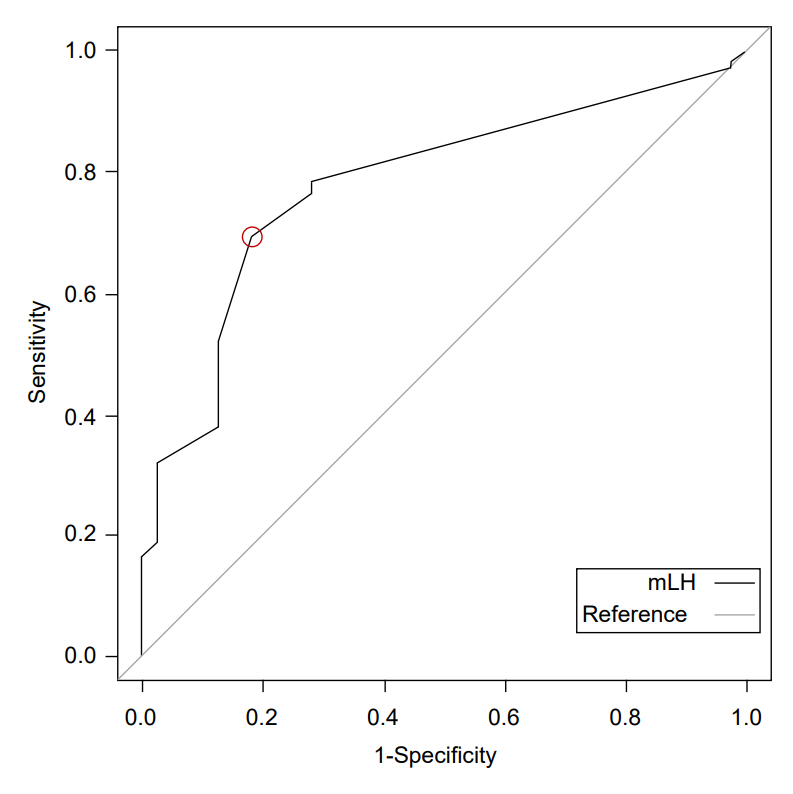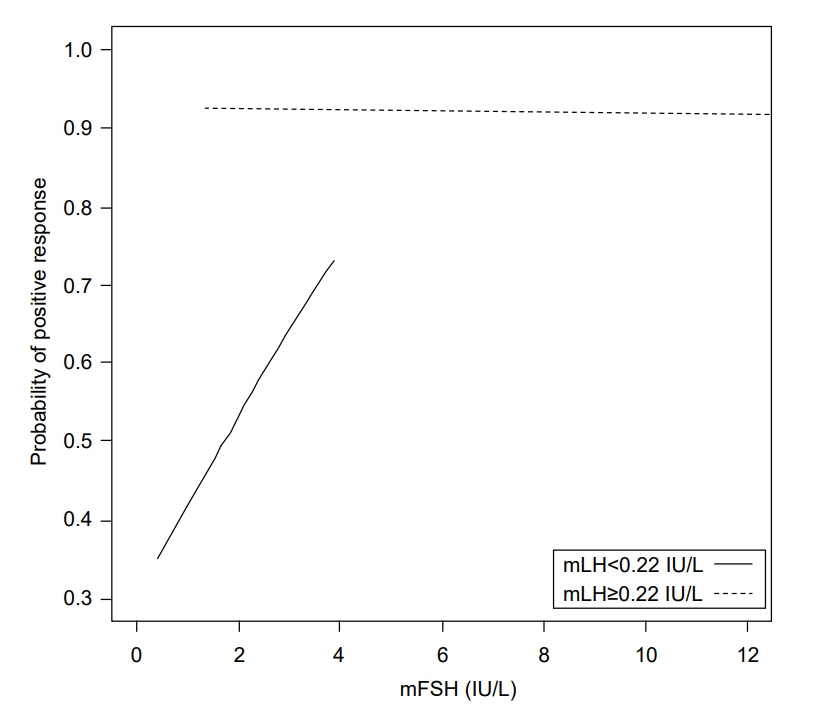Ann Pediatr Endocrinol Metab.
2019 Mar;24(1):27-33. 10.6065/apem.2019.24.1.27.
Morning basal luteinizing hormone, a good screening tool for diagnosing central precocious puberty
- Affiliations
-
- 1Department of Pediatrics, Yonsei University College of Medicine, Seoul, Korea.
- 2Department of Pediatrics, National Health Insurance Service Ilsan Hospital, Goyang, Korea. ped-endo@nhimc.or.kr
- KMID: 2447373
- DOI: http://doi.org/10.6065/apem.2019.24.1.27
Abstract
- PURPOSE
The standard method used to diagnose central precocious puberty (CPP) is the gonadotropin releasing hormone stimulation test (GnRHST). However, this test is inconvenient for children because it is time-consuming and requires multiple samples. This study aimed to determine the reliability of morning unstimulated luteinizing hormone (mLH) level when screening for CPP, with an emphasis on the influence of diurnal variation.
METHODS
This study included 160 girls with signs of early puberty (SMR 2) under 8 years of age. They were classified as CPP or non-CPP based on their standard GnRHST. The auxological, biochemical, and hormonal characteristics of subjects were retrospectively evaluated. The prognostic value of single morning unstimulated gonadotropin level was examined for use in CPP screening.
RESULTS
Of 160 patients, 121 (75.6%) presented with CPP, and 39 (24.4%) were determined to be prepubertal. The mLH/mFSH (morning unstimulated follicular stimulating hormone) ratio showed significant differences between the 2 groups (P<0.001). The mLH was correlated with GnRHST variables (r=0.532, P<0.001). The mLH cutoff point when screening for CPP was 0.22 IU/L, which had sensitivity and specificity of 69.4% and 82.1%, respectively. In regression analysis, bone age (BA) (odds ratio [OR], 1.018; 95% confidence interval [CI], 0.967-1.071; P=0.506) and body mass index (BMI) (OR, 0.874; 95% CI, 0.583-1.310; P=0.515) were not significant predictors. The mLH≥0.22 IU/L group (OR, 9.596; 95% CI, 3.853-23.900; P<0.001) was highly suggestive of CPP.
CONCLUSIONS
In this study, single morning unstimulated luteinizing hormone had clinical efficacy for CPP screening, but BA advanced over chronological age and BMI was not useful for CPP screening.
Keyword
MeSH Terms
Figure
Cited by 1 articles
-
Diagnosis and Treatment of Central Precocious Puberty
Han Saem Choi, Ho-Seong Kim, Hyun Wook Chae
Ewha Med J. 2021;44(4):117-121. doi: 10.12771/emj.2021.44.4.117.
Reference
-
References
1. Carel JC, Eugster EA, Rogol A, Ghizzoni L, Palmert MR; ESPE-LWPES GnRH Analogs Co analogs nsensus Conference Group, et al. Consensus statement on the use of gonadotropin-releasing hormone in children. Pediatrics. 2009; 123:e752–62.2. Lee PA. Central precocious puberty. An overview of diagnosis, treatment, and outcome. Endocrinol Metab Clin North Am. 1999; 28:901–18. xi.3. Boyar R, Finkelstein J, Roffwarg H, Kapen S, Weitzman E, Hellman L. Synchronization of augmented luteinizing hormone secretion with sleep during puberty. N Engl J Med. 1972; 287:582–6.
Article4. Aksglaede L, Sørensen K, Petersen JH, Skakkebaek NE, Juul A. Recent decline in age at breast development: the Copenhagen Puberty Study. Pediatrics. 2009; 123:e932–9.
Article5. Kim SH, Huh K, Won S, Lee KW, Park MJ. A significant increase in the incidence of central precocious puberty among Korean girls from 2004 to 2010. PLoS One. 2015; 10:e0141844.
Article6. Lee PA. Laboratory monitoring of children with precocious puberty. Arch Pediatr Adolesc Med. 1994; 148:369–76.
Article7. Brook CG. Precocious puberty. Clin Endocrinol (Oxf). 1995; 42:647–50.
Article8. Gaspari L, Paris F, Jeandel C, Sultan C. Peripheral precocious puberty in a 4-month-old girl: role of pesticides? Gynecol Endocrinol. 2011; 27:721–4.
Article9. Paris F, Gaspari L, Servant N, Philibert P, Sultan C. Increased serum estrogenic bioactivity in girls with premature thelarche: a marker of environmental pollutant exposure? Gynecol Endocrinol. 2013; 29:788–92.
Article10. Johnson GF, Dorst JP, Kuhn JP, Roche AF, Dávila GH. Reliability of skeletal age assessments. Am J Roentgenol Radium Ther Nucl Med. 1973; 118:320–7.
Article11. King DG, Steventon DM, O'Sullivan MP, Cook AM, Hornsby VP, Jefferson IG, et al. Reproducibility of bone ages when performed by radiology registrars: an audit of Tanner and Whitehouse II versus Greulich and Pyle methods. Br J Radiol. 1994; 67:848–51.12. Lynnerup N, Belard E, Buch-Olsen K, Sejrsen B, Damgaard-Pedersen K. Intra- and interobserver error of the Greulich-Pyle method as used on a Danish forensic sample. Forensic Sci Int. 2008; 179:242. e1-6.
Article13. van Rijn RR, Lequin MH, Robben SG, Hop WC, van Kuijk C. Is the Greulich and Pyle atlas still valid for Dutch Caucasian children today? Pediatr Radiol. 2001; 31:748–52.
Article14. Brito VN, Batista MC, Borges MF, Latronico AC, Kohek MB, Thirone AC, et al. Diagnostic value of fluorometric assays in the evaluation of precocious puberty. J Clin Endocrinol Metab. 1999; 84:3539–44.
Article15. Garnier PE, Chaussain JL, Binet E, Schlumberger A, Job JC. Effect of synthetic luteinizing hormone-releasing hormone (LH-RH) on the release of gonadotrophins in children and adolescents. VI. Relations to age, sex and puberty. Acta Endocrinol (Copenh). 1974; 77:422–34.
Article16. Roth JC, Kelch RP, Kaplan SL, Grumbach MM. FSH and LH response to luteinizing hormone-releasing factor in prepubertal and pubertal children, adult males and patients with hypogonadotropic and hypertropic hypogonadism. J Clin Endocrinol Metab. 1972; 35:926–30.17. Lee DS, Ryoo NY, Lee SH, Kim S, Kim JH. Basal luteinizing hormone and follicular stimulating hormone: is it sufficient for the diagnosis of precocious puberty in girls? Ann Pediatr Endocrinol Metab. 2013; 18:196–201.
Article18. Pasternak Y, Friger M, Loewenthal N, Haim A, Hershkovitz E. The utility of basal serum LH in prediction of central precocious puberty in girls. Eur J Endocrinol. 2012; 166:295–9.
Article19. Jakacki R, Kelch RP, Sauder SE, Lloyd JS, Hopwood NJ, Marshall JC. Pulsatile secretion of luteinizing hormone in children. J Clin Endocrinol Metab. 1982; 55:453–8.
Article20. Wu FC, Butler GE, Kelnar CJ, Huhtaniemi I, Veldhuis JD. Ontogeny of pulsatile gonadotropin releasing hormone secretion from midchildhood, through puberty, to adulthood in the human male: a study using deconvolution analysis and an ultrasensitive immunofluorometric assay. J Clin Endocrinol Metab. 1996; 81:1798–805.
Article21. Apter D, Bützow TL, Laughlin GA, Yen SS. Gonadotropinreleasing hormone pulse generator activity during pubertal transition in girls: pulsatile and diurnal patterns of circulating gonadotropins. J Clin Endocrinol Metab. 1993; 76:940–9.
Article22. Kang YS, Yoo DY, Chung IH, Yoo EG. Diurnal variation of gonadotropin levels in girls with early stages of puberty. Ann Pediatr Endocrinol Metab. 2017; 22:183–8.
Article23. Kim JR, Lee YS, Yu J. Assessment of bone age in prepubertal healthy Korean children: comparison among the Korean standard bone age chart, Greulich-Pyle method, and Tanner-Whitehouse method. Korean J Radiol. 2015; 16:201–5.
Article24. Greulich WW, Pyle SI. Radiographic atlas of skeletal development of the hand and wrist. 2nd ed. Stanford (CA): Stanford University Press;1999.25. Youden WJ. Index for rating diagnostic tests. Cancer. 1950; 3:32–5.
Article26. Brauner R, Adan L, Malandry F, Zantleifer D. Adult height in girls with idiopathic true precocious puberty. J Clin Endocrinol Metab. 1994; 79:415–20.
Article27. Golub MS, Collman GW, Foster PM, Kimmel CA, Rajpert-De Meyts E, Reiter EO, et al. Public health implications of altered puberty timing. Pediatrics. 2008; 121 Suppl 3:S218–30.
Article28. Abreu AP, Dauber A, Macedo DB, Noel SD, Brito VN, Gill JC, et al. Central precocious puberty caused by mutations in the imprinted gene MKRN3. N Engl J Med. 2013; 368:2467–75.
Article29. Bourguignon JP, Franssen D, Gérard A, Janssen S, Pinson A, Naveau E, et al. Early neuroendocrine disruption in hypothalamus and hippocampus: developmental effects including female sexual maturation and implications for endocrine disrupting chemical screening. J Neuroendocrinol. 2013; 25:1079–87.
Article30. Gajdos ZK, Hirschhorn JN, Palmert MR. What controls the timing of puberty? An update on progress from genetic investigation. Curr Opin Endocrinol Diabetes Obes. 2009; 16:16–24.
Article31. Wierson M, Long PJ, Forehand RL. Toward a new understanding of early menarche: the role of environmental stress in pubertal timing. Adolescence. 1993; 28:913–24.32. Marshall WA, Tanner JM. Variations in pattern of pubertal changes in girls. Arch Dis Child. 1969; 44:291–303.
Article33. Varimo T, Huttunen H, Miettinen PJ, Kariola L, Hietamäki J, Tarkkanen A, et al. Precocious puberty or premature thelarche: analysis of a large patient series in a single tertiary center with special emphasis on 6- to 8-year-old girls. Front Endocrinol (Lausanne). 2017; 8:213.
Article34. Partsch CJ, Heger S, Sippell WG. Management and outcome of central precocious puberty. Clin Endocrinol (Oxf). 2002; 56:129–48.
Article35. Flor-Cisneros A, Roemmich JN, Rogol AD, Baron J. Bone age and onset of puberty in normal boys. Mol Cell Endocrinol. 2006; 254-255:202–6.
Article36. Houk CP, Kunselman AR, Lee PA. Adequacy of a single unstimulated luteinizing hormone level to diagnose central precocious puberty in girls. Pediatrics. 2009; 123:e1059–63.37. Oerter KE, Uriarte MM, Rose SR, Barnes KM, Cutler GB Jr. Gonadotropin secretory dynamics during puberty in normal girls and boys. J Clin Endocrinol Metab. 1990; 71:1251–8.
Article38. Burt Solorzano CM, McCartney CR. Obesity and the pubertal transition in girls and boys. Reproduction. 2010; 140:399–410.
- Full Text Links
- Actions
-
Cited
- CITED
-
- Close
- Share
- Similar articles
-
- A case of idiopathic precocious puberty treated with a luteinizing hormone relaeasing hormone analog
- Diurnal variation of gonadotropin levels in girls with early stages of puberty
- The Utility of Basal Serum Luteinizing Hormone Levels for Screening Central Precocious Puberty in Girls
- Basal serum luteinizing hormone value as the screening biomarker in female central precocious puberty
- The Influence of Body Mass Index on Luteinizing Hormone Levels after Gonadotropin-Releasing Hormone Stimulation in Girls with Precocious and Advanced Puberty




